The AnandTech Coffee Lake Review: Initial Numbers on the Core i7-8700K and Core i5-8400
by Ian Cutress on October 5, 2017 9:00 AM EST- Posted in
- CPUs
- Intel
- Core i5
- Core i7
- Core i3
- 14nm
- Coffee Lake
- 14++
- Hex-Core
- Hyperthreading
Shadow of Mordor
The next title in our testing is a battle of system performance with the open world action-adventure title, Middle Earth: Shadow of Mordor (SoM for short). Produced by Monolith and using the LithTech Jupiter EX engine and numerous detail add-ons, SoM goes for detail and complexity. The main story itself was written by the same writer as Red Dead Redemption, and it received Zero Punctuation’s Game of The Year in 2014.
A 2014 game is fairly old to be testing now, however SoM has a stable code and player base, and can still stress a PC down to the ones and zeroes. At the time, SoM was unique, offering a dynamic screen resolution setting allowing users to render at high resolutions that are then scaled down to the monitor. This form of natural oversampling was designed to let the user experience a truer vision of what the developers wanted, assuming you had the graphics hardware to power it but had a sub-4K monitor.
The title has an in-game benchmark, for which we run with an automated script implement the graphics settings, select the benchmark, and parse the frame-time output which is dumped on the drive. The graphics settings include standard options such as Graphical Quality, Lighting, Mesh, Motion Blur, Shadow Quality, Textures, Vegetation Range, Depth of Field, Transparency, and Tessellation. There are standard presets as well.
We run the benchmark at 1080p and a native 4K, using our 4K monitors, at the Ultra preset. Results are averaged across four runs and we report the average frame rate, 99th percentile frame rate, and time under analysis.
All of our benchmark results can also be found in our benchmark engine, Bench.
MSI GTX 1080 Gaming 8G Performance

1080p


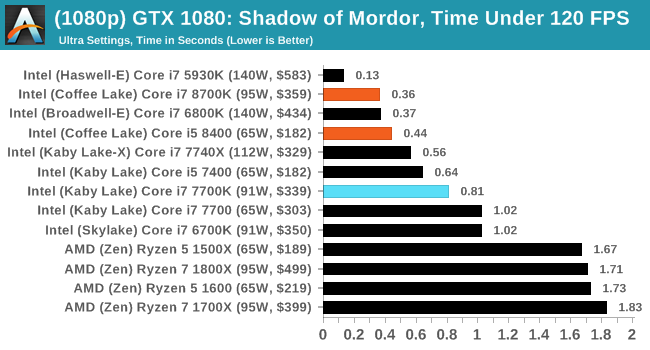
4K
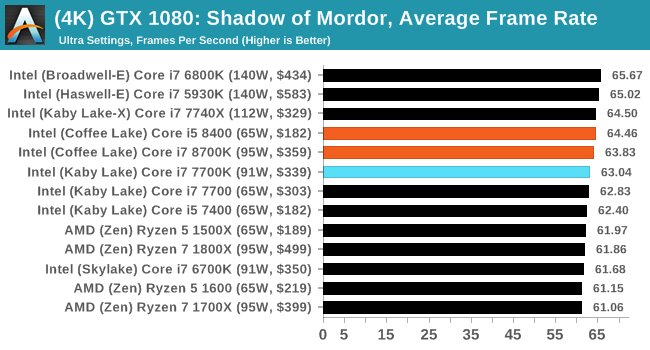
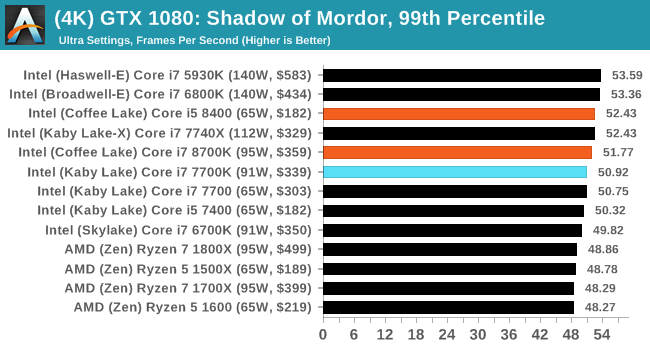
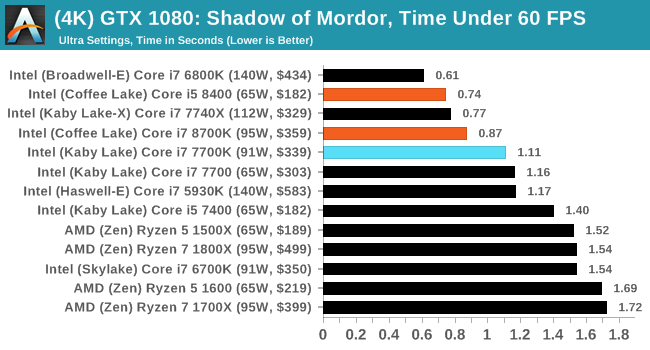


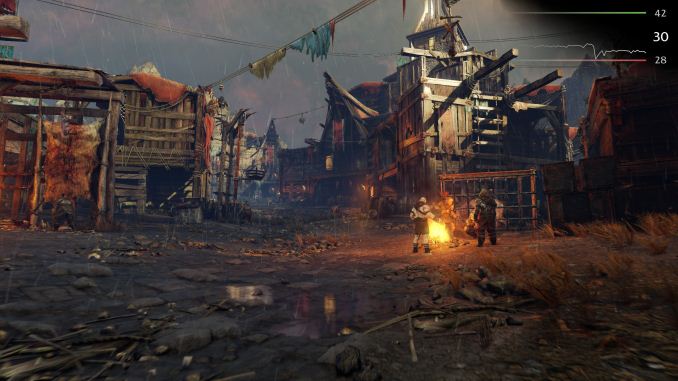
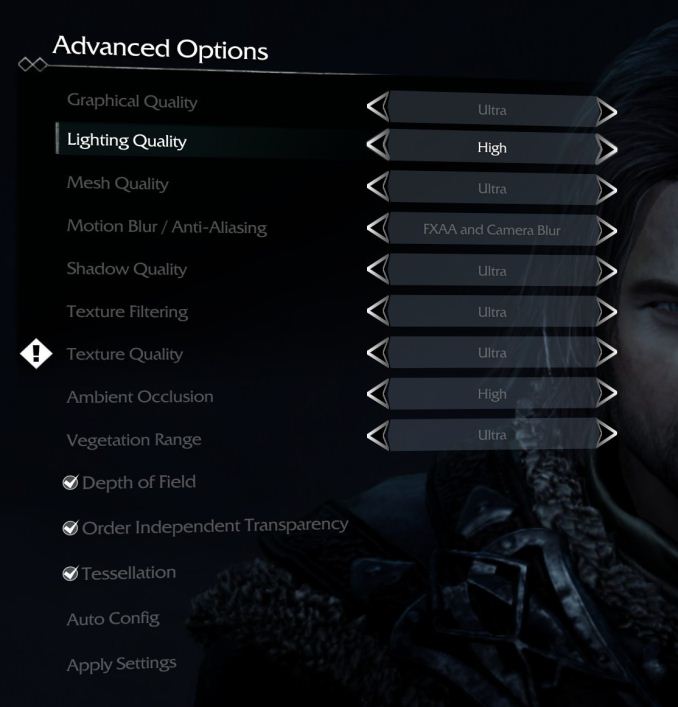








222 Comments
View All Comments
watzupken - Saturday, October 7, 2017 - link
There are pros and cons of having integrated graphics. It sure takes up a lot of die space, but it is something that allows Intel to sell a lot of chips. Amongst enthusiasts, this is unnecessary, but this group may only represent a small percentage vs corporates that need only decent CPU and no need for fancy graphics. To be honest, Intel could likely have created a 8 core processor easily since the die size is still fairly small for Coffee Lake, but they chose not to. I don't think it is a matter of the graphic that is holding them back.James5mith - Friday, October 6, 2017 - link
Now to wait for the generation of Intel CPU's with native Thunderbolt3 on-die like Intel announced earlier this year.Zingam - Saturday, October 7, 2017 - link
Why is that a good thing?ReeZun - Friday, October 6, 2017 - link
"The difference between the Ryzen 5 1500X and the Core i3-8350K would be interesting, given the extreme thread deficit (12 threads vs 4) between the two."The 1500X houses 8 threads (not 12).
watzupken - Saturday, October 7, 2017 - link
The difference between the R5 1500X and i3 8350K goes beyond just the number of threads. The cache is also 2x more on the Ryzen chip. However, the i3 chip have the advantage of being able to reach higher clockspeed. I do agree that this will be an interesting comparison.sweeper765 - Friday, October 6, 2017 - link
I'm not up to date with current bios versions.Is multi-core enhancement still present in z370 motherboards? That would get rid of all those differences in turbo speeds. I know it is technically overclocking but i bet it's a pretty safe procedure without increasing the voltages.
Also, what's the deal with the 8700? Is it just as good as 8700k (minus 100mhz) if one decides not to overclock? Just trying to gather as many practical facts as i can before formulating an upgrade plan (sandy bridge user hehe )
This cpu family looks good on specs and benches (maybe the first worthy successor to sandy bridge) but it's not perfect. I hate that Intel decided not to solder, i expect temperatures to soar in the high 80's. Also the current motherboards are somewhat lacking in ports (usb, lan, sata).
I love my sandy bridge setup though.
6 1/2 years old and still going strong. Overclocked, cool, stable, silent. With current cpu's you don't get all these points.
Even if i upgrade i'm not going to touch it.
Ian Cutress - Saturday, October 7, 2017 - link
Is multi-core enhancement still present in z370 motherboards?As an option, yes.
As default? Will vary board to board. You can disable it.
However we had trouble with one of our boards: disabling MCT/MCE and then enabling XMP caused the CPU to sit at 4.3 GHz all day. Related to a BIOS bug which the vendor updated in a hurry.
Jodiuh - Friday, October 6, 2017 - link
What’s up with those rise of Tomb Raider benchmarks? Am I too seriously believ the i5 7400 is more capable than the 8700K...did I miss the overclocking part?Tech reports review much better with results that make sense.
peevee - Friday, October 6, 2017 - link
"Core i5-8600K and the Core i7-8700. These two parts are $50 apart, however the Core i7-8700 has double the threads, +10% raw frequency"+10%? Count again.
boeush - Friday, October 6, 2017 - link
Regarding most normal/gaming scenarios, I'm wondering with the 8700/k whether one couldn't get an even better performance by disabling hyperthreading in the UEFI.That would still yield 6 threads, but now ostensibly with a full 2 MB of L3 per thread. Plus, lower power per core (due to lower resource utilization) might mean more thermal headroom and higher overall sustained frequencies.
So you'd get maximum-possible single-thread performance while still being able to run 6-wide SMT (which, under most normal usage, isn't even a constraint worth noting...)
Amirite?